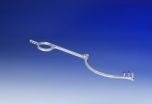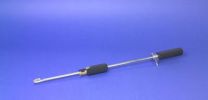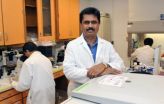Drug to fight tumors also fights the flu and possibly other viruses
New research published in the Journal of Leukocyte Biology suggests that a drug originally developed for cancer, called DMXAA, combats the flu virus by triggering the body to produce its own interferon
2011-03-01
(Press-News.org) Ever get a flu shot and still get the flu? If so, there's new hope for flu-free winters in the years to come thanks to a new discovery by researchers who found that a drug called DMXAA, originally developed as anti-tumor agent, enhances the ability of flu vaccines to ward off this deadly virus. A new research report appearing in the March 2011 issue of the Journal of Leukocyte Biology (http://www.jleukbio.org) suggests that DMXAA could assist flu vaccines by causing the body to produce its own antiviral proteins, called interferons, which interfere with the virus's ability to spread. In addition, DMXAA may be a useful antiviral therapy to treat newly emerging strains of the flu for which a vaccine has not be developed.
"We are hopeful that DMXAA or similar agents can be used ultimately to blunt the impact of yearly influenza outbreaks, and perhaps, for other virus infections as well," said Stefanie Vogel, Ph.D., co-author of the study and Professor of Microbiology and Immunology at the University of Maryland, School of Medicine in Baltimore.
To make this discovery, Vogel and colleagues infected mice with a mouse-adapted influenza strain. When given DMXAA three hours before or after infection and then two days later, the infection was significantly less severe. In addition, they found that DMXAA protected cells from flu strains that are resistant to Tamiflu®, one of the most advanced anti-flu drugs on the market. These discoveries suggest that DMXAA could potentially enhance the efficacy of current flu treatments and vaccines, and perhaps treat other viruses or bacteria. To be sure that DMXAA led to increased production of interferons, the researchers also tested it in mice that lacked a gene needed to produce interferon, and found that these mice received no benefit from DMXAA.
"H1N1 was a wake-up call that the flu remains a very serious disease, regardless of how "common" we may think it is," said John Wherry, Ph.D., Deputy Editor of the Journal of Leukocyte Biology. "Every year this virus mutates, and history has shown us that new, very dangerous strains of this virus will continue to emerge. New drugs like this one that can combat this virus—especially drugs that are effective against newly emerging strains—may prove to be lifesaving for millions of people around the world."
###
The Journal of Leukocyte Biology (http://www.jleukbio.org) publishes peer-reviewed manuscripts on original investigations focusing on the cellular and molecular biology of leukocytes and on the origins, the developmental biology, biochemistry and functions of granulocytes, lymphocytes, mononuclear phagocytes and other cells involved in host defense and inflammation. The Journal of Leukocyte Biology is published by the Society for Leukocyte Biology.
Details: Kari Ann Shirey, Quan M. Nhu, Kevin C. Yim, Zachary J. Roberts, John R. Teijaro, Donna L. Farber, Jorge C. Blanco, and Stefanie N. Vogel
The anti-tumor agent, 5,6-dimethylxanthenone-4-acetic acid (DMXAA), induces IFN-β-mediated antiviral activity in vitro and in vivo
J Leukoc Biol. March 2011 89:351-357; doi:10.1189/jlb.0410216 ; http://www.jleukbio.org/content/89/3/351.abstract
END
ELSE PRESS RELEASES FROM THIS DATE:
2011-03-01
Be it a heart transplant or a Cesarean section, every operation requires a wide variety of surgical instruments, from simple retractors, clamps, scalpels and scissors to more specialist devices such as cerclage wire passers, which surgeons employ to repair long, oblique fractures in bones. These are shaped in such a way as to half encircle the broken bone, and incorporate a hollow channel. In a process not unlike stringing a parcel for posting, thread or wire is fed through the channel around the damaged bone and then knotted in place, both to support the bone and to hold ...
2011-03-01
More and more often, abdominal surgeries are being carried out in a minimally invasive manner. A small incision in the abdominal wall is sufficient for the surgeon to be able to insert the instrument and make the organs visible with an endoscope. This technique is gentler and does not stress the body as much as traditional surgeries do. However, these minimally invasive surgeries pose a special challenge to the surgeons. In particular, the suturing – meaning joining the tissue with needle and suture material - demands great skill and dexterity. Very often, piercing the ...
2011-03-01
Part of the answer to how and why primates differ from other mammals, and humans differ from other primates, may lie in the repetitive stretches of the genome that were once considered "junk."
A new study by researchers at the University of Iowa Carver College of Medicine finds that when a particular type of repetitive DNA segment, known as an Alu element, is inserted into existing genes, they can alter the rate at which proteins are produced -- a mechanism that could contribute to the evolution of different biological characteristics in different species. The study was ...
2011-03-01
In an interesting bit of scientific serendipity, researchers at North Carolina State University have found that a chemical compound useful for studying the origins of intestinal birth defects may also inhibit the growth and spread of cancerous tumors.
During the screening of chemical compounds created by NC State chemist Dr. Alex Deiters, developmental biologist Dr. Nanette Nascone-Yoder found one of particular interest to her research: a compound that induced heterotaxia, a disordering or mirror-image "flipping" of internal organs, in the frog embryos she was studying. ...
2011-03-01
A daytime sleep could have cardiovascular benefits according to new research by Ryan Brindle and Sarah Conklin, PhD, from Allegheny College in Pennsylvania in the US. Their study, looking at the effect of a daytime nap on cardiovascular recovery following a stress test, found that those participants who slept for at least 45 minutes during the day had lower average blood pressure after psychological stress than those who did not sleep. The work is published in Springer's journal International Journal of Behavioral Medicine.
Long work schedules, shift work, increased anxiety ...
2011-03-01
A research study coordinated by Manel Esteller, researcher at Bellvitge Biomedical Research Institute (IDIBELL) has identified a substance that inhibits cancer growth by activating the so‑called "dark genome" (or non‑coding DNA) and micro‑RNA molecules. The study appears this week in the journal Proceedings of the National Academy of Sciences (PNAS).
Human body cells have a genome (the set of our DNA) encoding our proteins such as keratin in the skin or haemoglobin in blood. This genome with encoding DNA represents only the 5% of our genetic material. ...
2011-03-01
About 1,200 criminal justice researchers as well as active and retired law-enforcement professionals from around the world are expected to attend the annual meeting of the international Academy of Criminal Justice Sciences, to be held March 1-5 in Toronto. Presentations of the latest research in the field will be made, including research presented by the University of Cincinnati faculty and students.
Recognized at the conference will be UC researchers Bonnie Fisher, professor, and Francis Cullen, distinguished professor. Fisher and Cullen will receive the 2010 Outstanding ...
2011-03-01
Researchers from Boston University School of Medicine (BUSM) have found that patients with node negative T3 and T4 non-small lung cancer who underwent chemotherapy before surgery had more than three times the survival rate than patients who only underwent surgery. These findings currently appear on-line in the Journal of Thoracic and Cardiovascular Surgery.
The study looked at a total of 110 patients who underwent surgical resection for invasive T3 and T4 non-small lung cancer between 1979 and 2008. Forty-seven patients received neoadjuvant chemotherapy and concurrent ...
2011-03-01
AMES, Iowa - A protein pathway that may hold the secret to understanding Parkinson's disease has been discovered and explained by Iowa State University researchers.
Anumantha Kanthasamy, a distinguished professor of biomedical sciences and the W. Eugene and Linda R. Lloyd Endowed Chair in Neurotoxicology at the ISU College of Veterinary Medicine, has been working to understand the complex mechanisms of the disease for more than a decade. He believes this recent discovery offers hope for the cure.
The research was funded by the National Institutes of Health and is published ...
2011-03-01
WASHINGTON, February 28, 2011) – Results from a study published in Blood, the Journal of the American Society of Hematology reveal a close relationship between pulmonary arterial hypertension (PAH)—exceedingly high blood pressure in the arteries carrying blood from the heart to the lungs—and abnormalities of the blood-forming cells in the bone marrow (known as myeloid abnormalities).
The study, which was conducted by a team of researchers at the Cleveland Clinic, showed that blood progenitor cells (cells that are capable of forming white blood cells, red blood cells, ...
LAST 30 PRESS RELEASES:
[Press-News.org] Drug to fight tumors also fights the flu and possibly other viruses
New research published in the Journal of Leukocyte Biology suggests that a drug originally developed for cancer, called DMXAA, combats the flu virus by triggering the body to produce its own interferon



